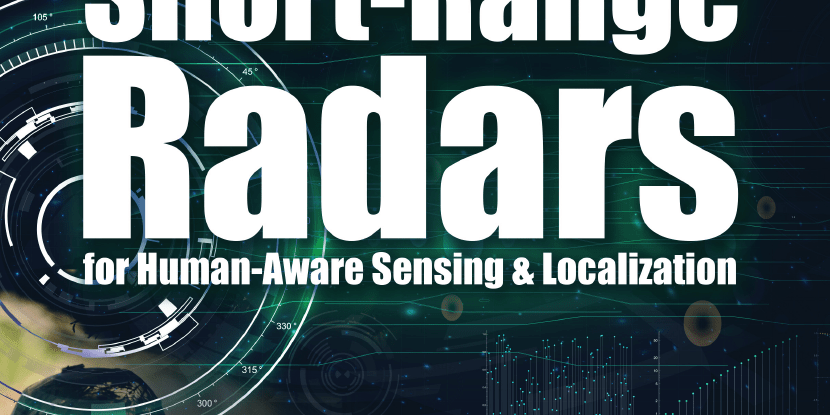Smart, portable, short-range (under 20 meters) radars in the microwave band have been investigated for use in human and animal vital sign detection over recent decades. Promising applications of this technology that have attracted the interest of microwave engineers and researchers include the wireless detection of human respiration, heartbeats, and vital sign monitoring during battlefield triage [1-9]. Beyond cardiorespiratory detection, gait analysis, gesture characterization, through-the-wall detection, and occupancy sensing, applications have emerged from research and development efforts in the interpretation of time-frequency analysis of short-range radar data [10-17].
In recent years, researchers from Texas Tech University (Texas Tech) developed portable short-range radar systems that can detect a subject’s respiration and heartbeat [18], track the location of human subjects [18, 19], differentiate human targets from other objects in the nearby environment [18, 20], and capture gesture and gait information—all of which operate within a maximum range of 20 meters [21]. The developed sensors are a 5.8 GHz hybrid radar that can operate in interferometry (Doppler) mode or frequency modulated continuous wave (FMCW) mode, a K-band FMCW beamforming radar, and a K-band 3D multiple-input-multiple-output (MIMO) radar.
When the devices are operating in the Doppler mode, a single tone of unmodulated continuous wave is transmitted in order to obtain the phase history of the targets. This mode achieves a high level of precision in displacement and speed measurement, but it cannot acquire absolute range information of targets. With the FMCW mode, it is possible to obtain precise absolute range of targets. Moreover, Doppler information related to the target’s radial velocity can be extracted, allowing for displacement measurements of targets if the coherence of the system is properly achieved.
However, when measuring low frequency motions—such as vital signs—the sensitivity of the FMCW mode may not be as good as that of the Doppler mode due to factors, such as imperfection in the transmitted FMCW chirp and additional errors introduced by the extra functional blocks. With these limitations in mind, careful consideration is made when picking which mode to use for the desired application, as currently the radars are not capable of operating simultaneously under both modes.
Compared with conventional contact-based sensors and camera-based solutions, microwave short-range radar systems display several advantages. Contact-based systems might cause discomfort when used for a prolonged time, whereas radar systems are not reliant on direct user contact. Also, since camera-based sensors rely on light to operate, they can be easily blocked by obstacles, and might not detect transparent materials. Both of these issues, not extant in radar systems, may limit their usefulness in Department of Defense military and homeland security operations. In addition, microwave systems present high sensitivity to vibrations, low power consumption, simple structure, and cost effectiveness.
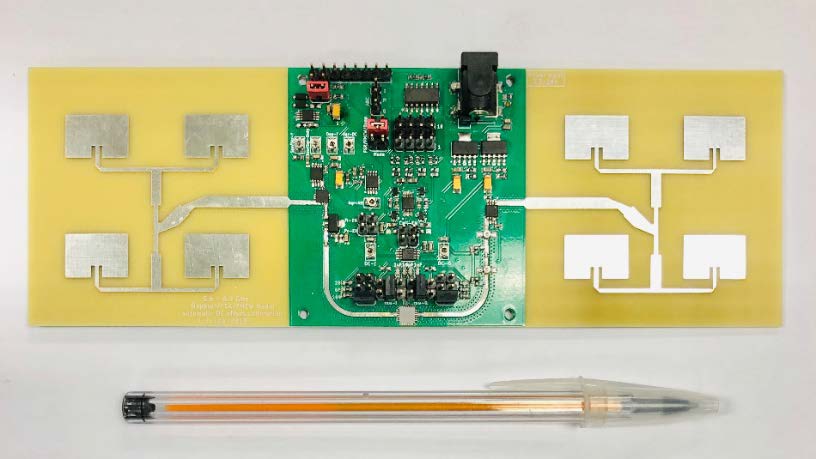
Figure 1. A portable 5.8 GHz hybrid integrated radar

Figure 1. A portable 5.8 GHz hybrid integrated radar
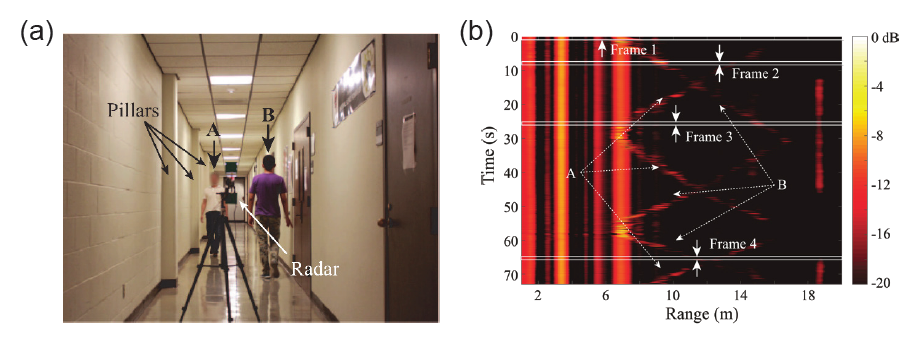
Figure 3. (a) Photograph of the experimental environment for human tracking (b) Range profile for two human subjects walking in opposite directions in a narrow corridor [18].
Non-contact Vital Signs Monitoring
Doppler radars are notably sensitive, allowing them to detect vital signs and provide millimeter or even submillimeter scale accuracy in displacement measurement. Using the Doppler mode of our 5.8-GHz hybrid radar sensor (see Figure 1), accurate respiration and heartbeat rates can be measured remotely without attaching anything to the human body. With this capability, the sensor can be used to monitor patients in hospital scenarios, detect the comfort state of drivers in vehicles, monitor sleep phases during the night, search for life after avalanches or earthquakes, and so on [16].
Researchers at Texas Tech and the University of Buffalo are investigating the possibility of using remotely detected cardiac waveforms as a form of identification and authentication for electronic devices [22]. For example, as it is assumed that the heartbeat waveform is unique for each person, the cardiac password could be used to authenticate the user’s signature heartbeat as soon as the user is close to their computer. If a different person attempts to log in or the user walks away from their computer, it would automatically lock down. Although this project is still in its early stages, it could potentially supplement existing biometric identification and authentication processes, and add additional security to such systems in the near future.
Figure 2 shows an example of non-contact vital signs detection when the sensor was placed 1.5 m away from the human subject. The respiration and heartbeat rates can be clearly identified.

Figure 4. (a) Frame 1 of the video at the beginning of data acquisition. (b) Frame 2 of the video at seven s. (c) Frame 3 of the video at 26 s. (d) Frame 4 of the ISAR video at 64 s. The two human subjects can be clearly identified [18].
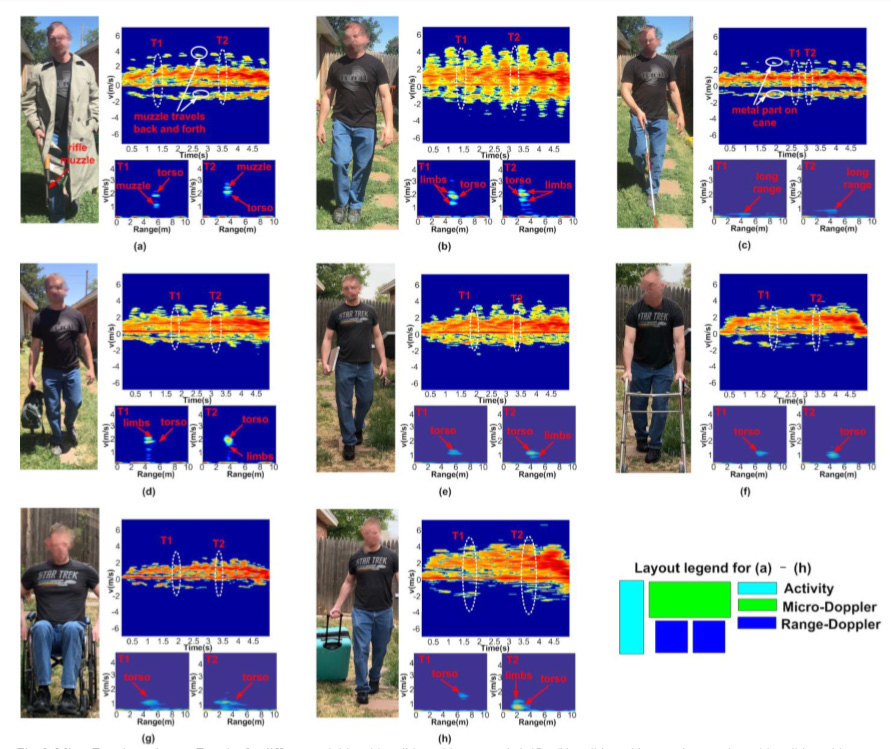
Figure 5. Micro-Doppler and range-Doppler for eight different activities: (a) walking with a concealed rifle, (b) walking with natural arm swings, (c) walking with a cane for a blind person and (d) walking while holding a gym bag, (e) walking while carrying a laptop, (f) walking with a walker, (g) moving in a wheelchair, and (h) walking with a rolling bag [21].
Human Tracking
Tracking human targets in a closed complex environment, such as a room in a corporate building, a house, or a clinical environment, is challenging. The presence of unwanted returned echoes from the ground, walls, or other objects (clutters) could affect the accurate detection of moving human targets. FMCW radars are quite precise in detecting range profiles of targets. However, in order to obtain Doppler information from the phase history of the targets, this system needs to be coherent. Our prototype 5.8 GHz hybrid radar’s FMCW mode combines the phase-resolved Doppler information and absolute range to form range-Doppler images. This 2D information enables location tracking of moving human subjects while also isolating those subjects from the surrounding clutters. In addition, a series of range-Doppler images can be integrated to form a real-time video.
Figure 3(a) shows the experiment setup and Figure 3(b) presents the range profile matrix for the experiment for a length of 73 seconds. The strong vertical strips seen in Figure 3(b) are due to the presence of stationary objects (wall and pillars) in the illuminated scenario.
Figure 4 is a series of range-Doppler images. Figure 4(a) is a frame of the range-Doppler video in which both subjects are motionless. As proof of the system’s coherence, the zero-Doppler echoes corresponding to the stationary objects are observable once the subjects’ velocities are zero. Figure 4(b) plots the frame corresponding to an instance seven seconds after starting data acquisition. At that moment, subject A was walking toward the radar, while subject B was walking away from the radar. The return associated with subject A appears above the zero-Doppler strip, while subject B provides an echo below the zero-Doppler signature.
Figure 4(c) and (d) show the two frames of the video (frames 3 and 4) corresponding to the instances at 26 seconds and 64 seconds, respectively. In relation to Figure 4(c), subject A was close to the radar and he planned to turn around with a velocity close to zero, while subject B was still walking away from the radar system. Regarding Figure 4(d), subject A was walking back to the radar and subject B was walking away from the radar. The echoes observed around the main signatures in Figure 4 correspond to the micro-Doppler features of the human gaits.
This system presents a tactical advantage for warfighters employed in military operations in urbanized terrain, as well as police officers in security operations—allowing the remote tracking of enemies or suspects with a portable, lightweight, and relatively lowcost device, under a maximum distance of 20 meters. Furthermore, its capability could be used for studying human motion behavior in a short-range area, such as a room, which could be helpful when determining the best moment to seize a position.
Human Behavior Recognition
The number of active shooting incidents has continued to rise in recent years. According to a 2018 Federal Bureau of Investigation report, the number of active shooting incidents rose from 20 incidents in 2016 to 30 incidents in 2017. Additionally, between 2016 and 2017, 52 percent of incidents in which shotguns or rifles were involved caused 79.6 percent of the total number of innocent deaths [23]. Currently, the technologies available for shooter detection are commonly based on acoustic gunshot identification and infrared camera gunfire flash detection [21]. Thus, these technologies are only able to generate a notification after the firearm has discharged. A shooter detection system that can identify a possible shooter armed with a concealed shotgun or rifle before the shooter has drawn them could potentially reduce the number of casualties in such events.
If the human subject has mechanical vibration or rotation beyond their bulk motion, a frequency modulation on the returned signal is induced, which generates sidebands on the target’s Doppler frequency shift. This is called the micro-Doppler effect, and it can be exploited to characterize human gaits or differentiate a human target from an animal. For example, it has been shown that the micro-Doppler signature of a human target is notably different from that of a dog [12].
Range-Doppler is another valuable radar signature for target identification. It provides velocity information of a moving target and tracks the distance between a walking person and the portable radar. Because of their individual properties, combining range-Doppler and micro-Doppler radar signatures can provide consistent information to analyze human gaits, gestures, and behavior. These two features can be obtained by a portable device operating in the interferometry and FMCW modes.
Figure 5 shows the micro-Doppler and range-Doppler signatures for eight different activities, as detected by our 5.8 GHz hybrid radar. Analysis of the micro-Doppler and the range-Doppler obtained from each image provided important features which were then used to identify a potential shooter. Thirteen human subjects were employed to perform these eight activities multiple times, and the data from each experiment was used to train an artificial neural network (ANN). From the study and analysis of the experimental data, five features were extracted and used as inputs for the ANN. The outputs of the ANN were the eight activities [21]. With these results, a false positive rate could be evaluated.
The results showed that the ANN had an accuracy rate of 99.21 percent when differentiating walking with a concealed rifle from the other seven innocuous activities. Just 6.3 percent of the samples of walking with natural arm swings (not holding anything) were erroneously recognized by the ANN as walking with a hidden rifle, while the rest of the innocuous activities were differentiated from walking with a concealed rifle [21]. Therefore, this relatively low cost solution—having the advantage of sensing through clothing and displaying minimal interference with normal indoor activities—could potentially add another layer of security to the traditional methods of shooter detection.

Figure 6. Proposed K-band FMCW beamforming radar. (a) Top view. (b) Bottom view.
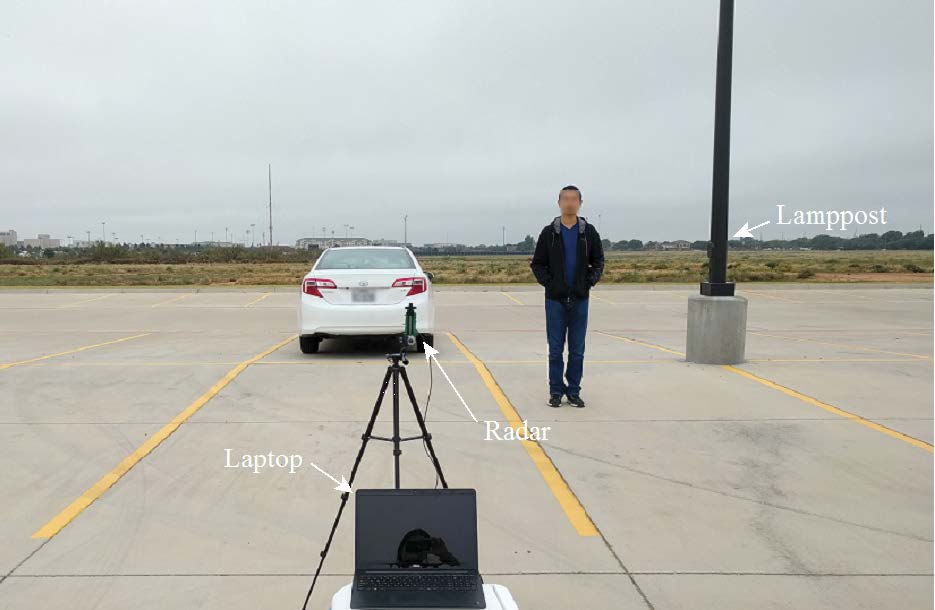
Figure 7. Experimental environment of short-range localization with a human subject and two object targets using the proposed radar prototype [19].

Figure 8. (a) Measured result of the short-range localization experiment with a human subject and two object targets using the proposed radar prototype. (b) Human target extracted with standard deviation of ten sequenced scans [19].
Human-aware Localization
The research group at Texas Tech developed a printed circuit K-band FMCW radar system that operates with a beamforming array. The presence of the phase array allows the radar system to perform a 2D short-range scan efficiently without requiring mechanical steering systems [19]. Figure 6 presents the proposed K-band FMCW beamforming radar.
Physiological motions, such as breathing, make it so that a live human target is never completely stationary. Also, the reflection surface of a human target is neither a perfect conductive surface nor even a flat plane. Moreover, tiny motions of the human body provoke a slight change in the target’s radar cross-section, causing a variation in the amplitude of the radar-detected range spectrum exactly in the range bins where the human subject is supposed to be. This is called the vital-Doppler effect. By analyzing the variation of the range spectrum detected by the K-band FMCW radar, living targets can be identified and the electronic beamforming array can discriminate stationary human beings among other non-living subjects in a large area without turning the radar.
Figure 7 is an image from the experiment where a human subject was placed in front of a car and a lamppost. The stationary beamforming FMCW radar scanned the scenario from -45 degrees to 45 degrees with a step size of 2.5 degrees. Figure 8(a) illustrates the measured result. Signatures of the car, the lamppost, and the human subject can be identified. It should be noted that the signature of the human subject is distinct, because the respiration and heartbeat create a vital-Doppler effect in the time history of that signature. To identify the human subject, ten sequences of FMCW scans were performed. The standard deviation of the detected range spectrum is represented in Figure 8(b). With this method, the signatures of the car and the lamppost are effectively suppressed, and the human signature can be extracted—achieving human-aware localization.
The human-aware localization of the K-band portable FMCW radar with beamforming could be employed as anti-camouflage. This feature could potentially help soldiers/ law enforcement officers find hidden suspects during a seizure. Its ability to detect vital-Doppler effects could provide awareness of the terrain, allowing for the quick identification and localization of human subjects based on their vital signs.
3D Short-range Localization
The MIMO technique can be used to improve the spatial resolution of radar systems, and it provides a decent 2D angular resolution while reducing the number of antenna channels. Nonuniformly spaced arrays can achieve higher angular resolution when compared with uniformly spaced arrays.
We combined these two techniques to create a K-band MIMO FMCW radar prototype. Figure 9 depicts the radio-frequency (RF) frontend diagram and the RF board of the radar.
In order to send commands to the radar platform and receive data from the platform, a Wi-Fi board is stacked on the backside of the baseband part of the prototype. It creates a Wi-Fi access point that can be connected by a computer or other portable device, such as a cellphone. Figure 10(a) presents the frontside of the baseband board and Figure 10(b) shows the Wi-Fi board, as seen from the backside of the baseband board.
From experiments with this prototype, the range, azimuth angle, and zenith angle of three targets were obtained [19], demonstrating the potential applications of this prototype in 3D short-range localization of human targets.
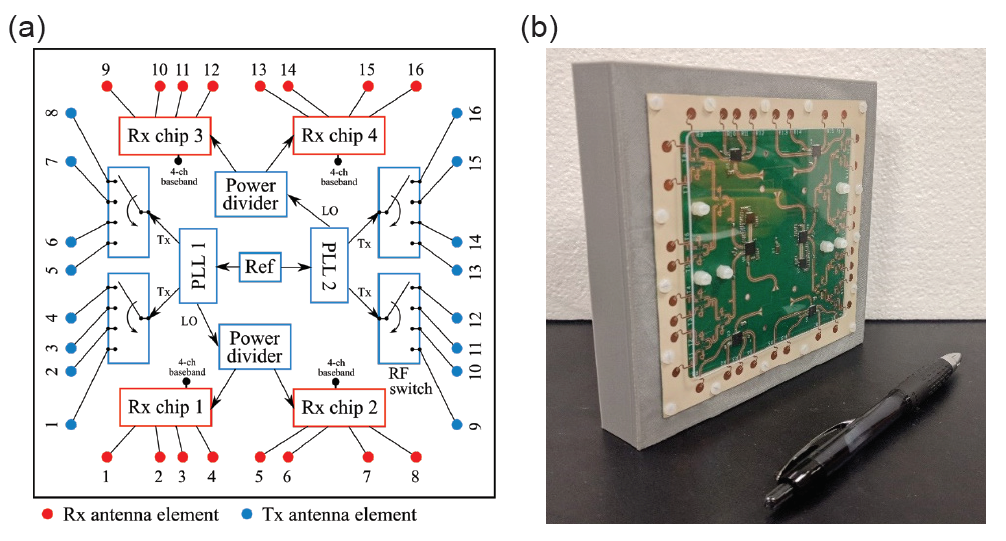
Figure 9. (a) RF front-end diagram and (b) RF front-end board of the K-band 3-D MIMO radar
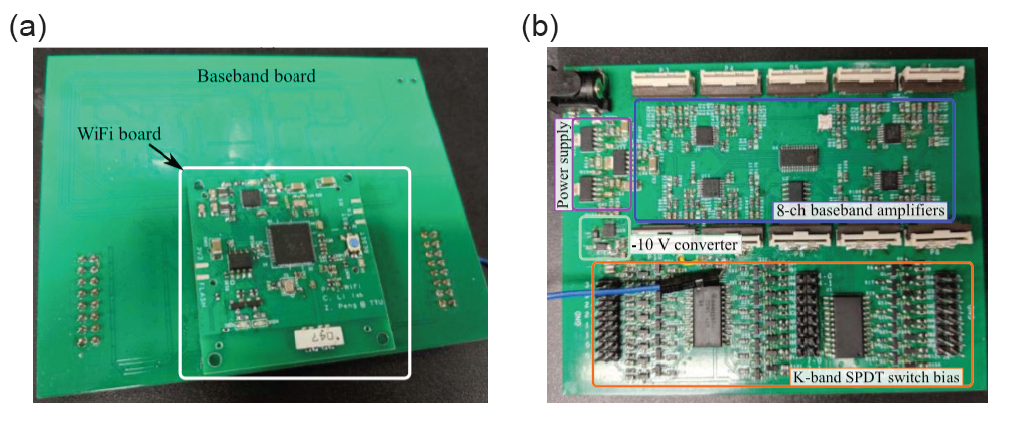
Figure 10. (a) Baseband board of the prototype and (b) Wi-Fi board of the K-band 3-D MIMO radar [20].
Conclusion
Human-aware sensing and short-range localization can be achieved by our smart, portable, short-range microwave radar systems. Our relatively low-cost, low-power systems effectively provide range-Doppler information. They offer beamforming to track human subjects, and provide reliable human-aware sensing and localization for the warfighter or first responder. This may lead to valuable and efficient tools with applications ranging from biomedical to security and military uses. Current contact-based and camera-based solutions face limitations, as they are sensitive to weather and ambient light conditions. Our sensors can fill this gap—contributing reliable information regarding human specific behaviors and potentially adding another much-needed layer of security to surveillance systems.
References
- Lin, J.C. (1975). Noninvasive microwave measurement of respiration. Proc. IEEE, 63(10), 1530.
- Huey-Ru, C., Chen, Y. F., Kun-Mu, C. (1991). Automatic clutter-canceler for microwave life-detection systems. IEEE Trans. Instrum. Meas, 40(4), 747–750. doi:10.1109/19.85346
- Lin, J.C. (1992). Microwave sensing of physiological movement and volume change: A review, Bioelectromagnetics, 13(6), 557– 565. doi:10.1002/bem.2250130610.
- Chen, Y. F., Yong, H., Jianping, Z. (2000). Microwave life detection systems for searching human subjects under earthquake rubble or behind barrier. IEEE Trans. Biomed. Eng., 47(1), 105–114. doi: 10.1109/10.817625.
- Droitocour, A.D., Boric-Lubecke, O.,Lubecke, V.M., Lin, J. (2002).0.25 µm CMOS and BiCMOS single-chip direct-conversion Doppler radars for remote sensing of vital signs. IEEE Int. Solid-State Circuits Conf. (ISSCC) Dig. Tech. Papers, 1, 348-349. doi:10.1109/isscc.2002.993075
- Xiao, Y., Lin, J., Boric-Lubecke, O., Lubeque, V.M. (2006). Frequency-tuning technique for remote detection of heartbeat and respiration using low-power double-sideband transmission in the Ka-band. IEEE Trans. Microwave Theory and Techniques, 54(5), 2023–2032. doi: 10.1109/ TMTT.2006.873625.
- Lin, J., Li., C. (2007). Wireless non-contact detection of heartbeat and respiration using low-power microwave radar sensor. Asia-Pacific Microw.Conf., 1-4. doi: 10.1109/ TMTT.2013.2256924.
- Boric-Lubeque, O., Lin, J., Park., B. K., Li., C., Massagram, W., Lubecke, Host-Madsen, A. (2008). Battlefield Triage Life Signs Detection Techniques. Proc. SPIE, 6947. doi:10.1117/12.781928.
- Li, C. et al (2013). A review on recent advances in Doppler radar sensors for noncontact healthcare monitoring. IEEE Trans. Microwave Theory and Techniques, 61(5), 2046– 2060. doi: 10.1109/TMTT.2013.2256924.
- Lubecke, V.M, Boric-Lubeque, O., Host-Madsen, A., Fathy, A.E. (2007). Through-the-wall radar life detection and monitoring. IEEE/MTT-S Inter. Microw. Sympos. doi: 10.1109/MWSYM.2007.380053.
- Wang, Y., Fathy, A.E. (2011). Micro-Doppler signatures for intelligent human gait recognition using a UWB impulse radar. Proc. IEEE Int. Symp. Antennas Propag. (APSURSI)., 16(2), 2103-2106. doi: 10.1109/ APS.2011.5996925.
- Otero, M. (2005). Application of a continuous wave radar for human gait recognition. Proc. SPIE, 5809, 538–548.
- Chen, V. C., Ling, H. (1999). Joint time-frequency analysis for radar signal and image processing. IEEE Signal Process. Mag., 16(2), 81-93. doi: 10.1109/79.752053.
- Chen, V.C. (2000). Analysis of radar micro-Doppler with time-frequency transform. Proc. 10th IEEE Workshop Statist. Signal Array Process.,463–466. doi:10.1109/ SSAP.2000.870167.
- Lien, J. et al.(2016). Soli: Ubiquitous gesture sensing with millimeter wave radar, ACM Trans. Graph, 35(4), 1-19. doi:10.1145/2897824.2925953.
- Li, C. et al (2013). A review on recent advances in Doppler radar sensors for noncontact healthcare monitoring. IEEE Trans. Microwave Theory and Techniques, 61(5), 2046– 2060. doi: 10.1109/TMTT.2013.2256924.
- Muñoz-Ferreras, J., Peng, Z., Gómez-García, R., Li, C. (2017). Review on advanced short-range multimode continuous-wave radar architectures for healthcare applications. IEEE Journal of Electromagnetics, RF, and Microwave in Medicine and Biology, 1(1), 14–25. doi: 10.1109/ JERM.2017.2735241.
- Peng, Z., Muñoz-Ferreras, J., Tang, Y., Liu, C., Gómez-García, R., Ran, L., Li, C. (2017). A Portable FMCW Interferometry Radar with Programmable Low-IF Architecture for Localization, ISAR Imaging and Vital-Sign Tracking. IEEE Transactions on Microwave Theory and Techniques, 65(4),1334–1344. doi:10.1109/TMTT.2016.2633352.
- Peng, C., Li, C. (2018). A portable K-band 3-D MIMO radar with nonuniformly spaced array for short-range localization. IEEE Transactions on Microwave Theory and Techniques, 66(11), 5075–5086. doi: 10.1109/TMTT.2018.2869565.
- Peng, Z., Ran, L., Li, C. (2017). A K-band portable FMCW radar with beamforming array for short-range localization and vital-Doppler targets discrimination, IEEE Transactions on Microwave Theory and Techniques, 65(9), 3443–3452. doi:10.1109/ TMTT.2017.2662680.
- Li, Y., Peng, Z., Pal, R., Li, C. (2017). Potential active shooter detection based on radar micro-Doppler and range-Doppler analysis using artificial neural network. IEEE Sensors Journal. doi: 10.1109/JSEN.2018.2879223.
- Lin, F., Song, C., Zhuang, Y., Xu, W., Li, C., Ren, K. (2017). Cardiac scan: a non-contact and continuous heart-based user authentication system. Proc. 23rd Annual International Conference on Mobile Computing. doi: 10.1145/3117811.3117839.
- The Advanced Law Enforcement Rapid Response Training (ALERRT) Center at Texas State University and the Federal Bureau of Investigation (FBI), U.S. Department of Justice, Washington, D.C. (2018). Active Shooter Incidents in the United States in 2016 and 2017


